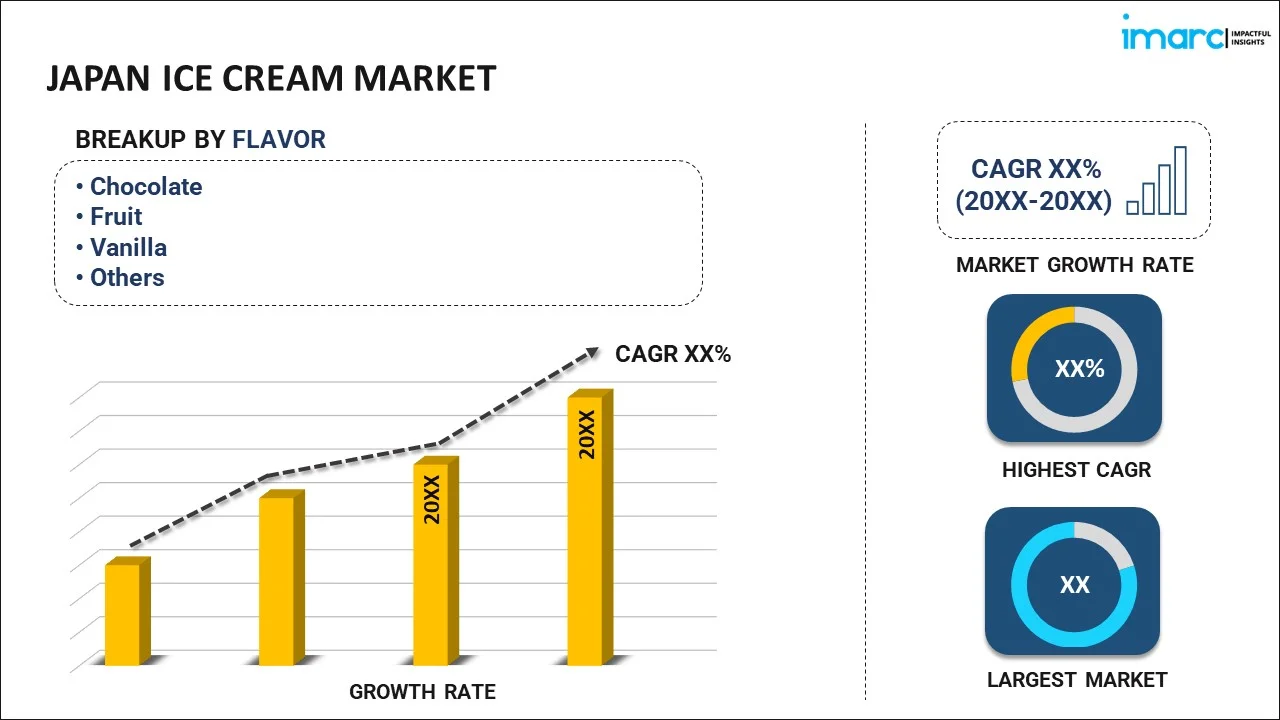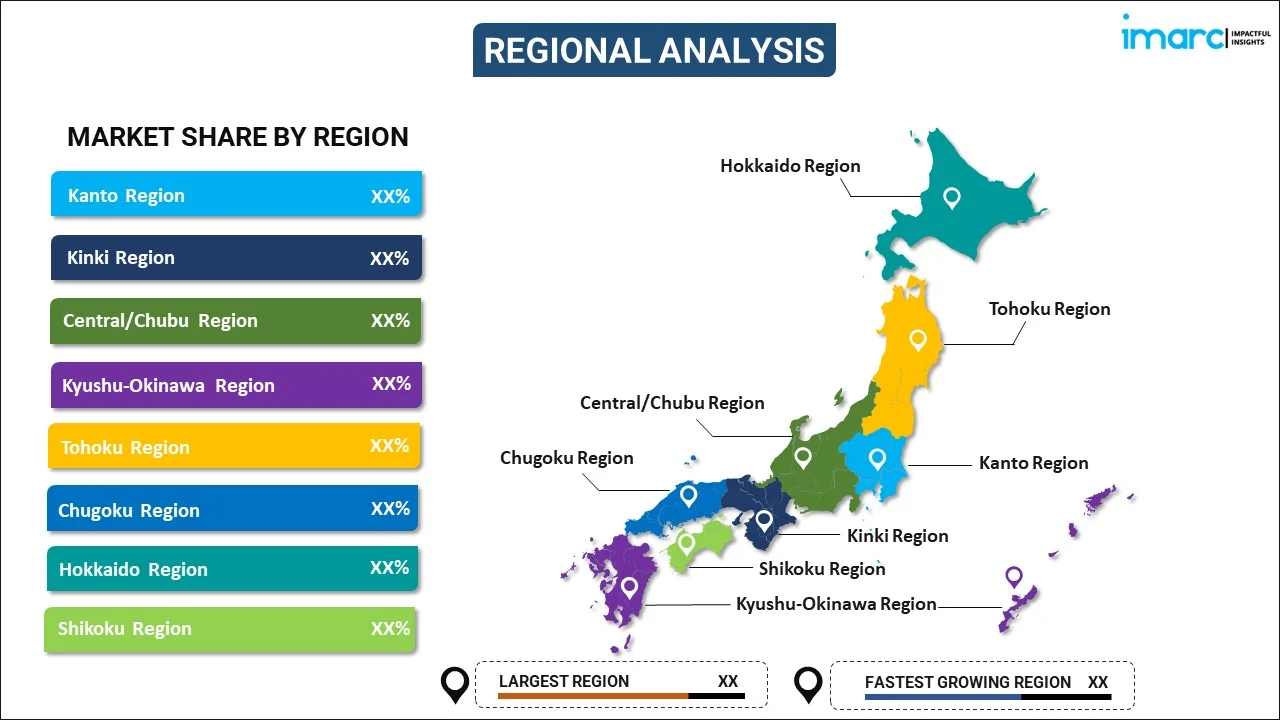
Japan Ice Cream Market Report by Flavor (Chocolate, Fruit, Vanilla, and Others), Category (Impulse Ice Cream, Take- Home Ice Cream, Artisanal Ice Cream), Product (Cup, Stick, Cone, Brick, Tub, and Others), Distribution Channel (Supermarkets/Hypermarkets, Convenience Stores, Ice Cream Parlours, Online Stores, and Others), and Region 2025-2033
Market Overview:
The Japan ice cream market size reached 834.2 Million Litres in 2024. Looking forward, IMARC Group expects the market to reach 1,097.9 Million Litres by 2033, exhibiting a growth rate (CAGR) of 2.70% during 2025-2033. The expansion of offline distribution channels in the country, the increasing disposable income of individuals, and the rising influence of local cultures and traditions in flavor innovation represent some of the key factors driving the market.
|
Report Attribute
|
Key Statistics
|
|---|---|
|
Base Year
|
2024
|
|
Forecast Years
|
2025-2033
|
|
Historical Years
|
2019-2024
|
|
Market Size in 2024
|
834.2 Million Litres |
|
Market Forecast in 2033
|
1,097.9 Million Litres |
| Market Growth Rate 2025-2033 | 2.70% |
Ice cream is a sweet, frozen food consumed as a dessert and snack. It is made using dairy products, such as milk and cream, fruits, chocolate, and other ingredients. It is available in a wide range of flavors, textures, and mix-ins that are fortified with high-fat content. It is stored at temperatures below freezing to maintain its consistency. It stimulates the thermoreceptors in the mouth, leading to increased mental alertness. It is widely used in other desserts, such as pies, sundaes, and ice cream sandwiches. It is also utilized in preparing innovative savory beverages, such as milkshakes and floats. It is served during social occasions, enhancing experiences, and fostering connections. Moreover, certain types of ice cream, especially those made with real fruits and nuts, provide essential minerals, vitamins C and A, and potassium. Besides this, as it aids in offering relief from the scorching heat on hot days due to its low temperature, the demand for ice cream is increasing across Japan.
Japan Ice Cream Market Trends:
The high-income levels of individuals in Japan and the rising influence of Westernization represent one of the key factors catalyzing the demand for premium ice cream products. Additionally, the hot and humid summer climate in Japan is influencing the overall sales. Apart from this, rising consumer preferences for gourmet, artisanal ice creams with high-quality ingredients and innovative flavors are offering a favorable market outlook. Furthermore, the expansion of offline distribution channels, such as supermarkets, hypermarkets, convenience stores, and confectionaries, is offering lucrative opportunities to industry investors. Besides this, many ice cream brands are collaborating with other food and beverage (F&B) companies to create co-branded flavors, bringing novelty and attracting new consumers. They are increasingly investing in various marketing strategies and promotional activities, such as celebrity endorsement and social media advertisements, to expand their market reach and increase overall profitability. Moreover, the rising consumer awareness about environmental health is encouraging ice cream producers in Japan to adopt environment friendly practices, such as using eco-friendly packaging and sourcing natural ingredients. Additionally, the expansion of hotels, restaurants, and cafes, expanding culinary tourism experience, along with the influence of local cultures and traditions in flavor innovation, helps in attracting domestic and international consumers. Furthermore, the development of products that cater to specific dietary needs, such as lactose intolerance and vegan population, is widening the consumer base and contributing to market growth. The easy-to-eat packaging, like single-serve cups and stick ice creams, is also creating a positive market outlook.
Japan Ice Cream Market Segmentation:
IMARC Group provides an analysis of the key trends in each segment of the Japan ice cream market report, along with forecasts at the country level for 2025-2033. Our report has categorized the market based on flavor, category, product, and distribution channel.
Flavor Insights:

- Chocolate
- Fruit
- Vanilla
- Others
The report has provided a detailed breakup and analysis of the market based on the flavor. This includes chocolate, fruit, vanilla, and others.
Category Insights:
- Impulse Ice Cream
- Take-Home Ice Cream
- Artisanal Ice Cream
A detailed breakup and analysis of the market based on the category has also been provided in the report. This includes impulse ice cream, take-home ice cream, and artisanal ice cream.
Product Insights:
- Cup
- Stick
- Cone
- Brick
- Tub
- Others
The report has provided a detailed breakup and analysis of the market based on the product. This includes cup, stick, cone, brick, tub, and others.
Distribution Channel Insights:
- Supermarkets/Hypermarkets
- Convenience Stores
- Ice Cream Parlours
- Online Stores
- Others
A detailed breakup and analysis of the market based on the distribution channel has also been provided in the report. This includes supermarkets/hypermarkets, convenience stores, ice cream parlours, online stores, and others.
Regional Insights:

- Kanto Region
- Kinki Region
- Central/Chubu Region
- Kyushu-Okinawa Region
- Tohoku Region
- Chugoku Region
- Hokkaido Region
- Shikoku Region
The report has also provided a comprehensive analysis of all the major regional markets, which include the Kanto region, Kinki region, central/Chubu region, Kyushu/Okinawa region, Tohoku region, Chugoku Region, Hokkaido region, and Shikoku region.
Competitive Landscape:
The report has also provided a comprehensive analysis of the competitive landscape in the market. Competitive analysis such as market structure, key player positioning, top winning strategies, competitive dashboard, and company evaluation quadrant has been covered in the report. Also, detailed profiles of all major companies have been provided.
Japan Ice Cream Market Report Coverage:
| Report Features | Details |
|---|---|
| Base Year of the Analysis | 2024 |
| Historical Period | 2019-2024 |
| Forecast Period | 2025-2033 |
| Units | Million Litres |
| Scope of the Report | Exploration of Historical and Forecast Trends, Industry Catalysts and Challenges, Segment-Wise Historical and Predictive Market Assessment:
|
| Flavor Covered | Chocolate, Fruit, Vanilla, Others |
| Categories Covered | Impulse Ice Cream, Take- Home Ice Cream, Artisanal Ice Cream |
| Products Covered | Cup, Stick, Cone, Brick, Tub, Others |
| Distribution Channels Covered | Supermarkets/Hypermarkets, Convenience Stores, Ice Cream Parlours, Online Stores, Others |
| Regions Covered | Kanto Region, Kinki Region, Central/ Chubu Region, Kyushu-Okinawa Region, Tohoku Region, Chugoku Region, Hokkaido Region, Shikoku Region |
| Customization Scope | 10% Free Customization |
| Post-Sale Analyst Support | 10-12 Weeks |
| Delivery Format | PDF and Excel through Email (We can also provide the editable version of the report in PPT/Word format on special request) |
Key Questions Answered in This Report:
- How has the Japan ice cream market performed so far and how will it perform in the coming years?
- What has been the impact of COVID-19 on the Japan ice cream market?
- What is the breakup of the Japan ice cream market on the basis of flavor?
- What is the breakup of the Japan ice cream market on the basis of category?
- What is the breakup of the Japan ice cream market on the basis of product?
- What is the breakup of the Japan ice cream market on the basis of distribution channel?
- What are the various stages in the value chain of the Japan ice cream market?
- What are the key driving factors and challenges in the Japan ice cream market?
- What is the structure of the Japan ice cream market and who are the key players?
- What is the degree of competition in the Japan ice cream market?
Key Benefits for Stakeholders:
- IMARC’s report offers a comprehensive quantitative analysis of various market segments, historical and current market trends, market forecasts, and dynamics of the Japan ice cream market from 2019-2033.
- The research study provides the latest information on the market drivers, challenges, and opportunities in the Japan ice cream market.
- Porter's five forces analysis assist stakeholders in assessing the impact of new entrants, competitive rivalry, supplier power, buyer power, and the threat of substitution. It helps stakeholders to analyze the level of competition within the Japan ice cream industry and its attractiveness.
- Competitive landscape allows stakeholders to understand their competitive environment and provides an insight into the current positions of key players in the market.
Need more help?
- Speak to our experienced analysts for insights on the current market scenarios.
- Include additional segments and countries to customize the report as per your requirement.
- Gain an unparalleled competitive advantage in your domain by understanding how to utilize the report and positively impacting your operations and revenue.
- For further assistance, please connect with our analysts.
 Inquire Before Buying
Inquire Before Buying
 Speak to an Analyst
Speak to an Analyst
 Request Brochure
Request Brochure
 Request Customization
Request Customization




.webp)




.webp)












